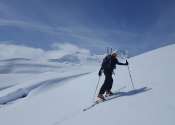Snow is a type of precipitation in the form of crystalline water ice, consisting of a multitude of snowflakes that fall from clouds. Since snow is composed of small ice particles, it is a granular material. It has an open and therefore soft structure, unless packed by external pressure. Snowflakes come in a variety of sizes and shapes. Types which fall in the form of a ball due to melting and refreezing, rather than a flake, are known as graupel, with ice pellets and snow grains as examples of graupel. Snowfall amount, and its related liquid equivalent precipitation amount, are determined using a variety of different rain gauges.
The process of precipitating snow is called snowfall. Snowfall tends to form within regions of upward motion of air around a type of low-pressure system known as an extratropical cyclone. Snow can fall poleward of their associated warm fronts and within their comma head precipitation patterns, which is called such due to its comma-like shape of the cloud and precipitation pattern around the poleward and west sides of extratropical cyclones. Where relatively warm water bodies are present, for example due to water evaporation from lakes, lake-effect snowfall becomes a concern downwind of the warm lakes within the cold cyclonic flow around the backside of extratropical cyclones. Lake-effect snowfall can be locally heavy. Thundersnow is possible within a cyclone's comma head and within lake effect precipitation bands. In mountainous areas, heavy snow is possible where upslope flow is maximized within windward sides of the terrain at elevation, if the atmosphere is cold enough.
Once on the ground, snow can be categorized as powdery when fluffy, granular when it begins the cycle of melting and refreezing, and eventually ice once it packs down, after multiple melting and refreezing cycles, into a dense mass called drift. When powdery, snow moves with the wind from the location where it originally landed, forming deposits with a depth of several meters in isolated locations. After attaching to hillsides, blown snow can evolve into a snow slab, which is an avalanche hazard on steep slopes. The existence of a snowpack keeps temperatures colder than they would be otherwise, as the whiteness of the snow reflects most sunlight, and the absorbed heat goes into melting the snow rather than increasing its temperature. The water equivalent of snowfall is measured to monitor how much liquid is available to flood rivers from meltwater which will occur during the upcoming spring. Snow cover can protect crops from extreme cold. If snowfall stays on the ground for a series of years uninterrupted, the snowpack develops into a mass of ice called glacier. Fresh snow absorbs sound, lowering ambient noise over a landscape due to the trapped air between snowflakes acting to minimize vibration. These acoustic qualities quickly minimize, and reverse once a layer of freezing rain falls on top of snow cover. Walking across snowfall produces a squeaking sound at low temperatures. For motion pictures, the sound of people walking across snow are duplicated through the use cornstarch, salt, and cat litter.
The terms blizzard or snow storm can describe a heavy snowfall. Snow shower is a term for an intermittent snowfall, while flurry is used for very light, brief snowfalls. Snow can fall as much as one meter at a time during a single storm in flat areas, and meters at a time in rugged terrain, such as mountains. When snow falls in significant quantities, travel by foot, car, airplane and other means becomes highly restricted, and mobility is decreased to the use of snowmobiles and skis. Although numerous recreational activities occur in snow-covered landscapes, hiking becomes more dangerous due to the reduced mobility and loss of traditional landmarks to help determine your location. When heavy snow occurs early in the fall, significant damage occurs to trees still in leaf. Areas with significant snow each year can store the winter snow within an ice house, which can be used to cool structures during the following summer.









